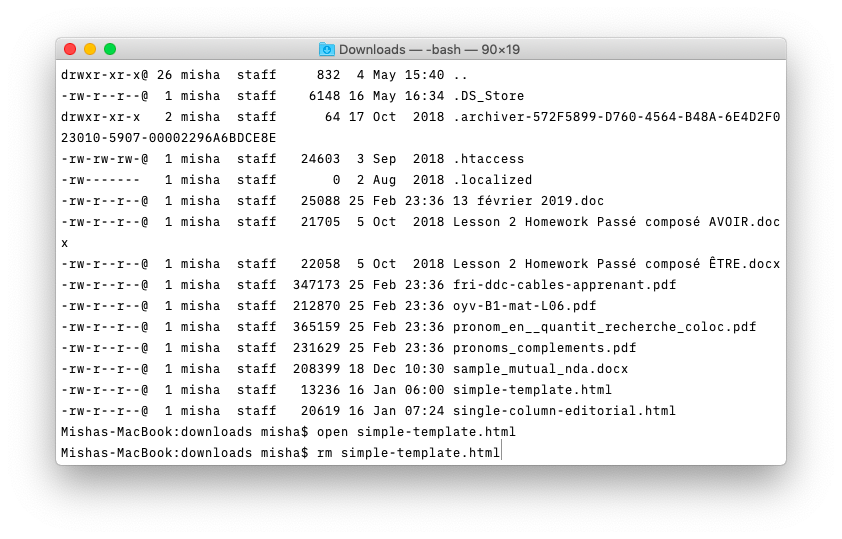

- #Mac terminal commands make directory how to
- #Mac terminal commands make directory code
- #Mac terminal commands make directory Pc
- #Mac terminal commands make directory free
- #Mac terminal commands make directory mac
Of course, anyone can find these files using the methods listed above, so this is not a real substitution for file encryption or any other legitimate security measures. Open Terminal and write the following:ĭrag the file you wish to hide into the Terminal window to display its path
#Mac terminal commands make directory mac
This would be most helpful if you have password-protected files or just want to prevent anyone who uses your Mac from messing around with something that's not already hidden. This method might seem less helpful than going through Finder, but Terminal can also help you hide individual files and folders on your computer. Type defaults write AppleShowAllFiles false and press Enter When you want to hide these files again, replace the value true with false, which would look like:
#Mac terminal commands make directory code
Once both lines of code run, you should see your hidden files in Finder and any temporary files saved on the desktop. Type defaults write AppleShowAllFiles true and press Enter Find Terminal under Launchpad > Other > Terminal, then run the following commands:
#Mac terminal commands make directory how to
How to Set Up Two-Factor AuthenticationĪnother way of performing this task is by using the macOS Terminal app, which gives you text-based access to the computer's operating system. #Mac terminal commands make directory Pc
How to Record the Screen on Your Windows PC or Mac. How to Convert YouTube Videos to MP3 Files. How to Save Money on Your Cell Phone Bill. #Mac terminal commands make directory free
How to Free Up Space on Your iPhone or iPad.How to Block Robotexts and Spam Messages.You can create multiple directories by separating the names with spaces.
• Select New Folder in the drop-down menu that appears. Example usage:mkdir If you want to create a new directory, use the mkdir command, followed by the name of the directory that you want to create. 
mkdir /Photos, Create a new folder called Photos.
Click File in the upper-left corner of the screen. UNIX & OS X Commands Reference mkdir Photos, Create a new folder called Photos in the current directory. Open Finder and navigate to the directory where you want to create the folder. Type a name for the folder and then press Return. Select New Folder from the drop-down menu that appears. Right-click (tap two fingers on the trackpad or multi-touch mouse) any blank space on the desktop. Creating a folder in macOS Desktop folder See the MS-DOS user section above for information about creating a directory in MS-DOS. Open the folder where you want to place the new folder, and on the top menu of File Manager, select File and then new folder. If you want to change the permissions of a directory after it is created, use the chmod command.Ĭreating a folder and directory in Microsoft Windows 3.X File Manager To remove the directory (if it is empty), use the rmdir command. Once the new directory is created, you can use the cd command to change and move to that directory. This command creates a "test" directory in the hope directory. To create a subdirectory in a different directory without moving to it, use a command similar to the example below. How to go back in folder directories Terminal Mac go back command in linux go to another dir in terminal mac how to move back i terminal how to go back. The example below moves back one directory to create the "example" directory. To create a directory in the parent directory without first moving to that directory, you can use the command below. You can now navigate folders using the Mac terminal to your heart’s content. Navigate Folders Using The Mac Terminal: Putting it all together. In the example below, we create a "my example directory" in the current directory. Use rm, rm -R, and rm -i to delete files and folders. The mkdir command stands for Make Directory. mkdir command: To create a new directory, code2caremac Documents mkdir myDir code2caremac Documents cd myDir code2caremac myDir pwd /Users/code2care/Documents/myDir code2caremac myDir. cp is the command to copy using a terminal, -r makes it recursively (so, current directory + further directories inside current) /folder1 is the origin. The pwd command stands for Print Working Directory. If you want to create a directory with spaces, you need to surround the directory name with quotes. What commands can you do on Terminal 17 Terminal Commands Every Programmer Should Know. dscl Directory Service command line utility du Estimate file space usage echo Display message on screen ed A line-oriented text editor (edlin) enable Stop or. In the following example, we are creating three new directories, called "user1," "user2," and "user3," in the current directory. An A-Z Index of the Apple OS X command line (TERMINAL) The tcsh command shell of Darwin (the open source core of OSX) alias Create an alias. You can also create multiple new directories in the current one with the md command. For example, below, we are creating a new directory called "hope" in the current directory. To create a directory in MS-DOS or the Windows Command Prompt ( cmd), use the md or mkdir MS-DOS command. It is more appropriate to use the term "directory" instead of "folder" when referring to the command line.






 0 kommentar(er)
0 kommentar(er)
